Do you find that certain muscle groups are hard as f*$k to grow? Yet others grow without much work? Ever wonder if other people have the same problem? If so, then stick around. Because today, I’ll be sharing the 14 easiest and hardest muscles to build (based on 646 user opinions).
The easiest muscles to build include the; trapezius, quadriceps, latissimus dorsi, triceps, rhomboids, spinal erectors, and gluteus Maximus. The hardest muscles to build include the; abs, calves, forearms, biceps, deltoids, hamstrings, and pectorals.
Below, I’ll examine why each muscle is hard or easy to develop, and how you can grow them.
Let’s get stuck in!

How I Ranked The 14 Easiest And Hardest Muscles To Build
First, I tracked down 8 Quora and Reddit polls that asked:
- What’s the easiest muscle group to build?
- What muscle grows the fastest?
- Which muscles are the easiest to get large?
- What muscle was easiest for you personally to develop?
- What is your hardest muscle to train? And what is the easiest?
- Which is the hardest muscle to grow in the gym, in your opinion?
- What is the hardest muscle to work out?
- What has been your hardest muscle group to grow and how did you overcome it?
Next, I tallied the 646 user opinions for the easiest and the hardest muscles to build.
Each muscle was then given an upvote if it was stated as being the easiest to build, and a downvote for being stated as the hardest muscle to build.
Note: in cases where an entire muscle group was stated, I gave each of the constituent muscles a vote. For example- the back would give trapezius, rhomboids, latissimus dorsi, and spinal erectors each an individual vote.
Finally, I ranked each muscle from the easiest to the hardest muscle to build.
Here are the results:
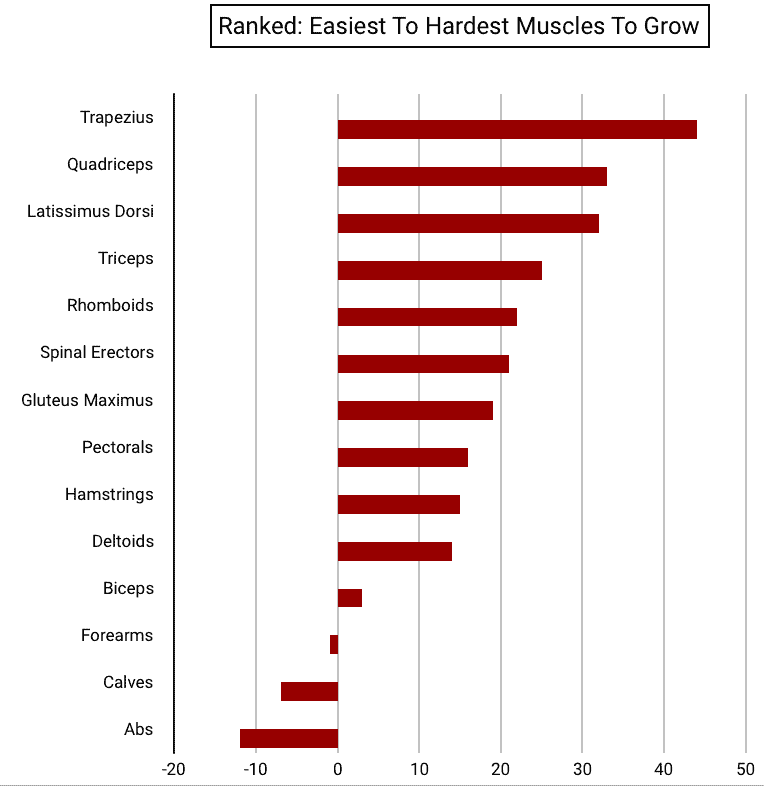
Next, I processed the poll results to rank each of the hardest and easiest muscles to build:
| Rank | Hardest Muscles To Build | Easiest Muscles To Build |
|---|---|---|
| 1 | Abdominals | Trapezius |
| 2 | Calves | Quadriceps |
| 3 | Forearms | Latissimus dorsi |
| 4 | Biceps | Triceps |
| 5 | Deltoids | Rhomboids |
| 6 | Hamstrings | Spinal erectors |
| 7 | Pectorals | Gluteus maximus |
Next, I’ll explore each muscle’s function.
I’ll also analyze why each muscle is easy or hard to develop, and explain how to train them effectively.
The 7 Easiest Muscles To Build.
Here are the 7 easiest muscles to build in descending order (easiest to hardest):
1) Trapezius.
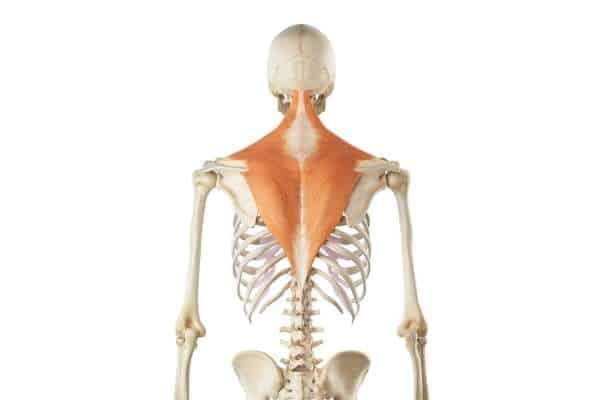
This large muscle is by far one of the easiest quoted muscles to build.
The trapezius (“traps”) function is to rotate and stabilize the shoulder blade to move your upper arm.
Furthermore, many people stated that they did not need dedicated exercises to train the trapezius.
Instead, their traps grew as a result of performing other compound movements.
When you develop big traps, the coveted “neck flare” will emerge. This is the muscle that connects your shoulders to your neck.
Why the trapezius is easy to build:
Many of the common compound lifts, including the deadlift and row, directly activate the trapezius.
Additionally, other compound exercises such as the bench press and shoulder press also engage the traps as a stabilizer muscle
The widespread use of the traps in many different exercises may explain why it’s one of the easiest muscles to build!
How to build the trapezius:
- Deadlift
- Bent-over row.
- One-arm row.
- Upright row.
- Face-pull.
- Dumbbell shrug.
- Incline reverse fly.
If your training program is well-balanced, trapezius training is not essential. Most of your upper body exercises will hit the traps on the side.
But at least you now know what exercises to perform to get traps like a King Cobra!
2) Quadriceps.
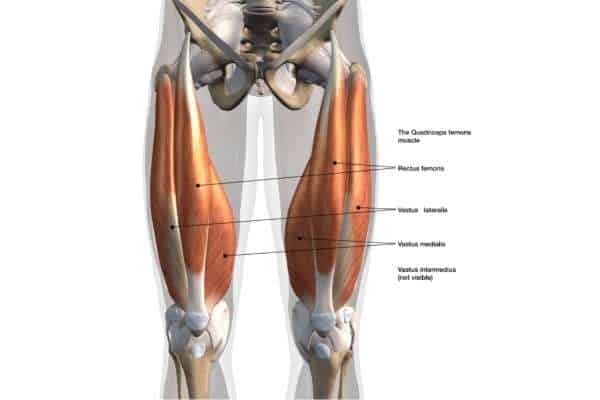
The quadriceps consists of 4 smaller muscles.
These four muscles work together to flex your hips upwards and extend your knees outwards.
The “quads” as they are sometimes called, are one of the biggest muscles in your body.
As well as being responsible for moving the hips and knees, they also stabilize your standing.
When you develop thick quads, you’ll be able to see all the distinct muscles which make up the quadriceps. And this contributes to building powerful-looking legs.
Why the quadriceps are easy to build:
The quads drive the majority of lower body exercises since these exercises almost always involve leg pushing movements.
This makes the quadriceps one of the most heavily activated muscles in the lower body.
They are also engaged to stabilize upper body exercises that require you to stand (for example the standing shoulder press and lateral raise).
Finally, the quadriceps can be easily isolated through exercises such as the leg extension machine.
How to build the quadriceps:
- High-bar back squat.
- Hack squat.
- Front squat.
- Leg press machine.
- Dumbbell goblet squat.
- Knee extension machine.
The best way to build your quads is through compound squatting.
The front squat is particularly effective since the weight is concentrated directly above the quadriceps. But all squats in general are great for the quadriceps.
Knee extensions are also a popular exercise.
But I would prioritize the squats, and then use knee extensions as an accessory exercise (to be done after squats).
If you’re looking to get an affordable squat set-up at home, my choice would be through Amazon.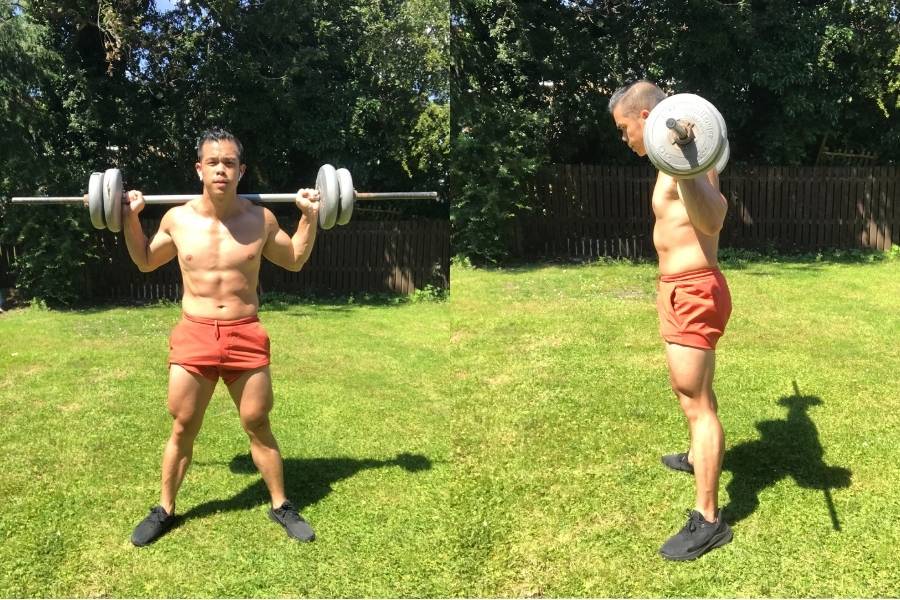
I’ve used a cheap barbell in the past but found that I quickly outgrew the weight (it also started rusting very quickly).
If you’re serious about squatting at home, I’d recommend this CAP Olympic barbell. It’s very durable and goes well with the Balance From cast iron plates and Bang Tong rack. You can upgrade the weight by getting more plates.
This is one of the most cost-effective setups to squat (as well as deadlift) heavy at home. But you’ll need at least 20 square feet of space to store and use.
Check out my other article to find out how much weight you should squat!
3) Latissimus Dorsi.
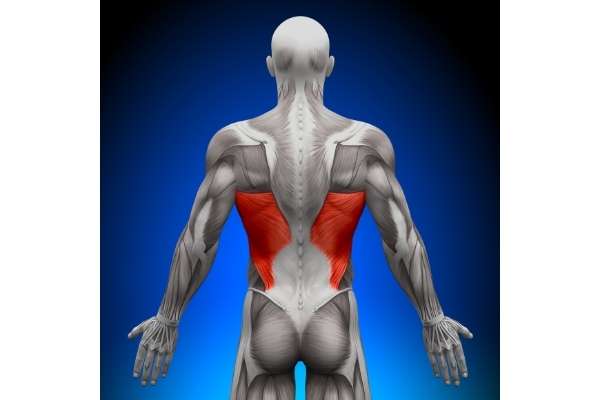
The latissimus dorsi, or “lats” is a large thin muscle that spans the entire lower back.
When they contract, it leads to arm adduction, pulling your arms down and back toward your torso.
Many of the most popular weight training exercises will engage also engage the lats as a secondary or primary stabilizer.
But to get big lats, you’ll need to work on specific exercises.
When the latissimus dorsi become trained, they will flare out (when viewed from the front). And this contributes to the highly sought V-shaped body.
Looking to build bigger muscles? You might be interested in my other post for details on how long it actually takes to get buff.
Why the latissimus dorsi is easy to build:
Although you need to make a conscious effort to include the lats in your training program, they are one of the largest and most powerful back muscles.
When you choose the right exercises, they can be one of the most receptive muscles for hypertrophy (muscle growth).
Additionally, the best lat exercises are often very popular and many people enjoy performing them.
How to build the latissimus dorsi:
- Wide-grip pull-up.
- Wide-grip chin-up.
- Bent-over row (pulling towards the belly button).
- Seated upright row machine.
- Lat pull-down machine.
The lats are difficult to isolate by themselves. But they can be targeted by performing the compound exercises above.
My personal favorite back exercise for a flared back is the pull-up. It’s difficult to do for beginners but it’s also one of the most effective.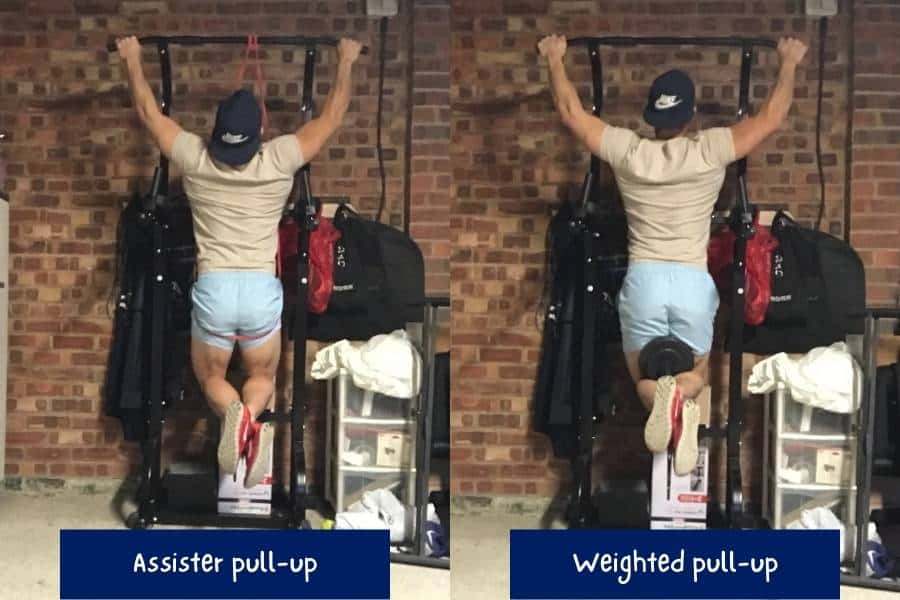
To practice pull-ups and chin-ups at home, I use and recommend the Sports Royal pull-up tower. It’s affordable and doesn’t damage your walls like a screw-in pullup bar does.
But the obvious downside is the footprint- the tower takes up just under 9 square feet of floor space.
The above exercises are all upper body pulling movements, and will also engage other muscles (especially the biceps).
This makes it important to account for your total weekly sets. You should avoid performing more than 15 heavy sets per muscle group per week.
If you’re interested, you can read my other article to learn how to do a pull-up!
4) Triceps.

The triceps are the largest muscle in your arms. In fact, they occupy around two thirds of your upper arm!
This makes training the triceps essential. But many beginners often neglect this muscle, which is also a highly receptive muscle for hypertrophy.
The good news is that the triceps are one of the easiest arm muscles to train.
When you build your triceps, they will give a well-defined “cut” look in your upper arms. And many people find this visually more appealing than the classic “bicep bulge”!
Why the triceps are easy to build:
Not only are the triceps the largest arm muscle, but they are also invariably recruited in all the upper body pressing and pushing movements (which are some of the most popular exercises).
Think of the bench press, shoulder press, and chest dip.
These are exercises every guy should include in their training program. And these exercises, as well as their variations, recruit the triceps as a primary mover.
However, to get those awesome cut triceps, you should also include tricep isolation exercises like the overhead extension.
How to build the triceps:
- Bench press.
- Close-grip bench press.
- Shoulder press.
- Skull crusher.
- Overhead tricep extension.
- Tricep kickback.
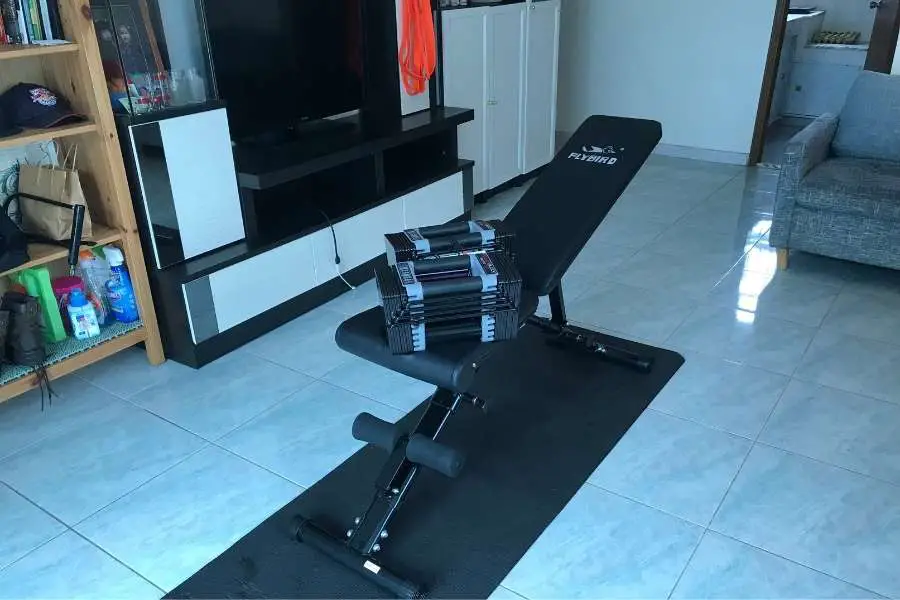
A dumbbell and bench setup allow you to perform all of these exercises. I use the Powerblock Elite with the Flybird adjustable bench.
The Powerblocks are fully adjustable- the lighter settings are great to isolate your triceps whilst the heavier settings are perfect for heavy compound lifting.
The Flybird bench (link for my hands-on test and review) is affordable, foldable, and also adjustable (allowing you to work your chest as well as triceps).
Be wary not to overtrain your triceps, since you’ll most likely be including other pressing exercises in your weekly routine as well.
I would suggest beginners limit themselves to 3-5 tricep isolation sets per week (skull crusher, extensions, and/or kickbacks). This will ensure you don’t hit the triceps with too many sets.
You can read my other article to learn how to get bigger arms!
5) Rhomboids.
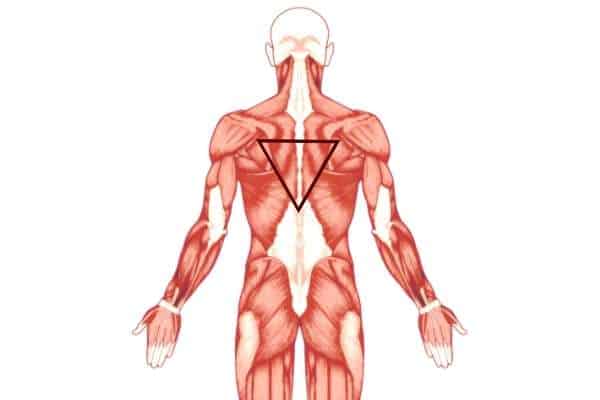
The rhomboids are two muscles located next to your trapezius, in the middle of your upper back.
They are responsible for pulling your shoulder blades together.
When you develop your rhomboids, you’ll also build a thick-looking back.
That’s because they lie in the center of your back (unlike the lats which are responsible for widening your back).
This means they will help to push your back muscles outwards.
Why the rhomboids are easy to build:
Although the rhomboids themselves can be difficult to isolate due to their location, many of the popular back exercises will engage the rhomboids.
This means you don’t need to worry about including dedicated rhomboid exercises in your training program.
Just make sure you perform a variety of compound back exercises with good form, and you’ll hit the rhomboids at the same time!
How to build the rhomboids:
- Bent-over row.
- Reverse fly.
- Pull-up.
- Face-pull.
- Seated upright row.
Form is the most important aspect of successfully engaging your rhomboids. Each of the exercises above will work your rhomboids.
But to ensure maximal rhomboid activation, you should fully retract your shoulder blades at the top of each movement. This will often mean sacrificing weight for form, which is never a bad idea!
The easiest way to do this is with dumbbells like the Powerblocks.
If you’re interested, you can check out my other post to learn how to bodybuild using nothing but dumbbells.
6) Spinal Erectors.
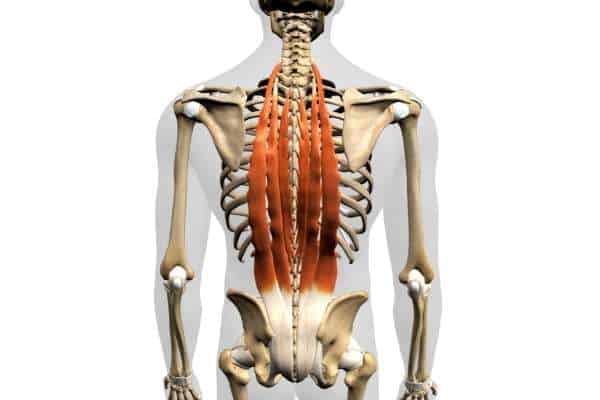
The spinal erectors are a group of muscles lying deep in your back.
They are mostly involved in extending your back and maintaining a good posture. But they are also important for stabilizing all back exercises.
Although well-developed spinal erectors won’t do much for aesthetics, they WILL help you to lift heavier weights on your back exercises.
And this will give you an overall benefit in developing the other back muscles.
Why the spinal erectors are easy to build:
If you’re including a good variety of back exercises, you don’t require dedicated exercises for the spinal erectors. They will develop alongside your other back muscles.
The deadlift is an excellent way to train the spinal erectors, as your back extends across the entire range of motion.
But most back exercises, in general, require spinal erector activity to maintain a straight back and stabilize the movement.
How to build the spinal erectors:
- Deadlift.
- Romanian deadlift
- Good morning.
- Bent-over row.
- Bird dog.
- Superman.
As long as you’re performing the big compound back exercises (rows and deadlifts), you don’t need smaller exercises such as the bird dog or superman.
However, you can include these exercises, should you wish, to do postural work or use them as a warm-up.
Check out my other article to find out how much weight you should be deadlifting.
7) Gluteus Maximus.
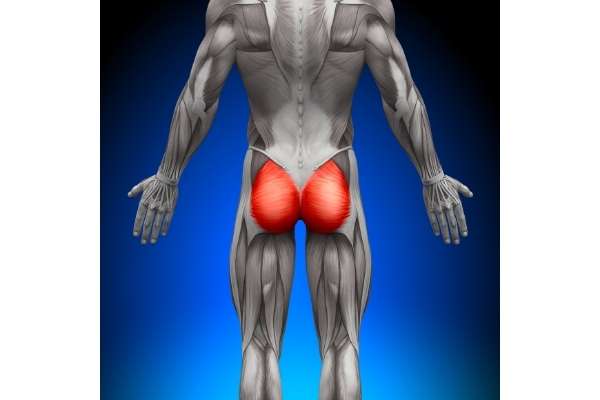
The gluteus maximus is located where your buttocks are.
It’s also the largest muscle in your body and is responsible for pushing your hips outwards as well as bringing your leg backward.
Developing the “glutes” will not only give aesthetic benefits but also functional advantages.
That’s because every lower body exercise will invariably require glute activity.
Likewise, most lower body exercises work the gluteus maximus as either the prime mover or secondary stabilizer.
Looking to quickly gain weight and don’t mind putting on some fat along with muscle? Then you might be interested in checking out my other post to learn how to put on 10lbs in 30 days!
Why the gluteus maximus is easy to build:
The gluteus maximus is one of the primary drivers for two of the most popular exercises- the deadlift and squat.
Most people will already have these exercises in their training programs. And this alone is sufficient to promote hypertrophy in the gluteus maximus (just make sure you’re lifting heavy).
This makes it easy to train the glutes without having to dedicate specific exercises.
How to build the gluteus maximus:
- Deadlift.
- Sumo deadlift
- Low-bar back squat.
- Lunge.
- Hip thrust.
If you are already performing 10-15 weekly sets of heavy deadlifts, squats, or lunges, then there’s good news- your glutes are getting a good workout already!
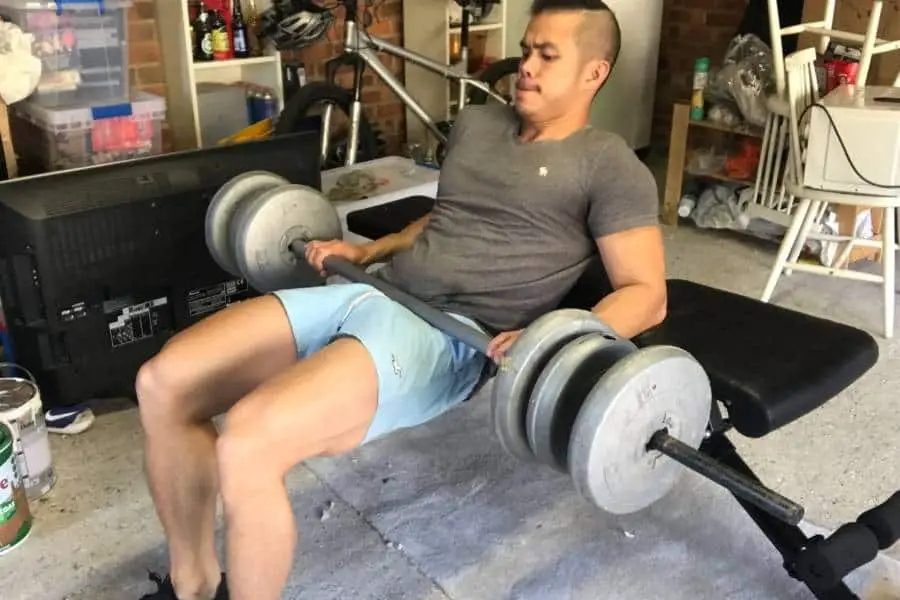
But if you want to add more sets to specifically the glutes, then the hip thrust is a great exercise.
To do this at home, you’ll need a barbell like the CAP Olympic barbell and weight plates like the Balance From cast iron plates. You’ll also need a good bench like the Flybird if you don’t already have one.
Unlike the other exercises, the hip thrust exclusively targets the gluteus maximus (although the hamstrings are also engaged to a degree).
The 7 Hardest Muscles To Build.
Here are the 7 hardest muscles to build in descending order (hardest to easiest):
1) Abdominals.
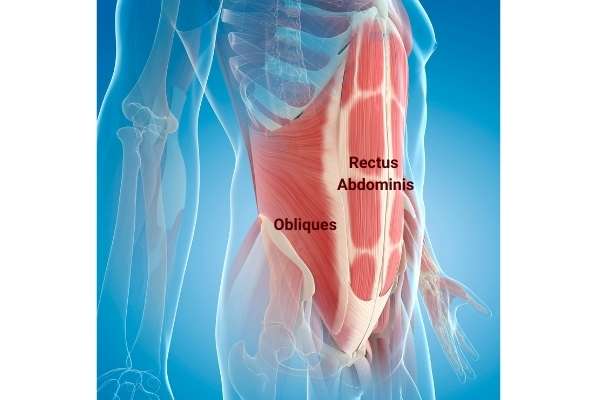
The abdominals are a group of muscles located in your core, aka the six-pack muscles.
These muscles are mainly comprised of the rectus abdominis and obliques.
They work together to flex your back (bringing your head towards the knees) as well as rotate the torso.
According to the poll, the abs are one of the hardest muscles to build (and also the most coveted!).
But aesthetics-aside, a strong core will provide functional benefits to all your big lifts, allowing you to lift heavier weights.
Why the abdominals are hard to build:
The muscles themselves are not hard to isolate, and there are many exercises to target both the rectus abdominis and obliques.
My favorite is the decline sit-up.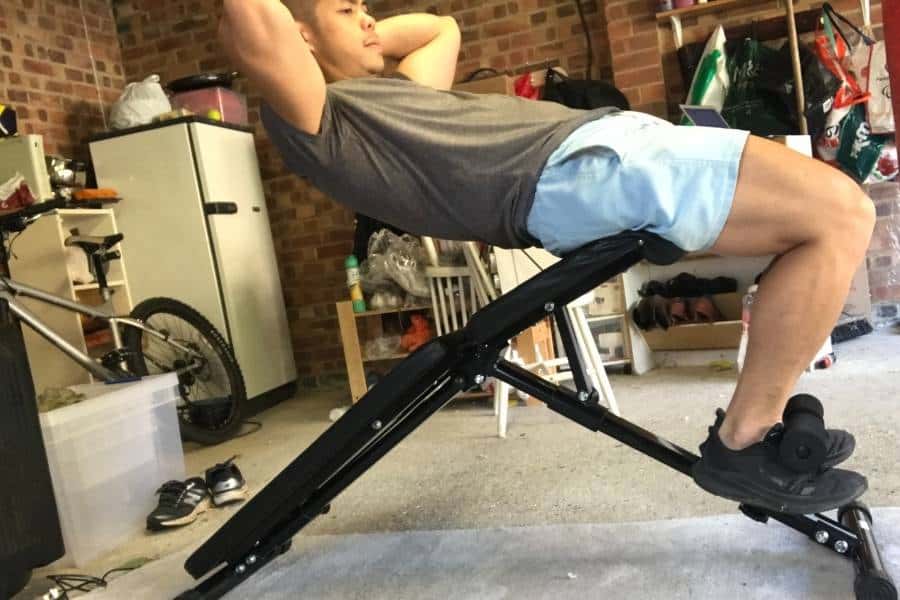
To do this at home, you’ll need a decline bench like the Flybird and any form of free weight to hold against your chest (I use Powerblock Elites which can be found on Amazon).
What many people struggle with is revealing the abdominal definition, since the torso is also the first place where fat is stored.
This essentially covers any definition from the abs.
How to build the abdominals:
- Weighted crunch (upper abs).
- Wood chopper abs and obliques).
- Side-bend (obliques)
- Leg raise (lower abs).
- Russian twist (obliques).
- All compound exercises.
To train the abs most effectively, you need variety. In fact, out of all the muscle groups, variation is especially important to build a powerful core.
That’s because each section of your abdominals performs distinct roles.
So choose a selection of exercises that work the upper abs, lower abs, and obliques!
And don’t forget about nutrition!
You’ll need to be on lean bulk in order to build your abs whilst maintaining definition.
Check out my other article to learn how to keep your abs on a bulk!
2) Calves.

The gastrocnemius makes up the bulk of the calf muscle.
The muscle itself is responsible for flexing the foot downwards (onto your tiptoes), as well as flexing your lower leg towards your thighs.
You will want to develop this muscle as it’s the main muscle in the lower leg and thus contributes to powerful-looking legs.
Why the calves are hard to build:
The calves are regarded to be one of the most difficult muscles to build for two reasons.
Firstly, they are constantly engaged through daily activities such as walking and running. As a result, most people already have a degree of calf development, and this makes it harder to drive further development.
Secondly, the calves are constantly used throughout the day. And this means the calves need a level of endurance.
As such, they have a high proportion of slow-twitch muscle fibres (50% to be exact).
These fibers are responsible for long and sustained movements and are harder to grow compared to fast-twitch fibres.
How to build the calves:
- Squats.
- Deadlift.
- Dumbbell calf raise.
- Barbell calf raise.
- Standing calf-raise machine.
- Seated calf-raise machine.
Deadlifting and squatting provide a lot of stimulation for the calf muscle.
But that’s rarely enough if you want to get big calves.
Instead, you should also incorporate calf-raises in your training program.
These can be performed with free weights or machines. But If possible, go for the machines.
Unlike free weights, which require a lot of balancing, machines make it easier to control the muscle and get a good mind-muscle contraction.
Read my other article to find out how often you should perform leg days!
3) Forearms.

The forearms are mainly made up of the brachioradialis, wrist flexors, and forearm flexors.
These work together to flex your wrists towards the forearm, as well as rotate the wrists.
The most important function of the forearm is to provide grip strength. And without a strong grip strength, you’re limited in the amount of weight you can lift in all exercises.
This makes it very important to train your forearms.
Why the forearms are hard to build:
Your forearms are used consistently in every workout. So why are they one of the hardest muscles to build?
Just like the calves, the forearms contain a lot of slow-twitch fibers. And these are mostly used for aerobic endurance activities.
As a result, it can be difficult to develop strength and mass in the forearm muscles.
How to build the forearms:
- Underhand wrist-curl.
- Overhand wrist-curl.
- Hammer curl.
- Reverse curl
- Compound exercises such as pull-ups and deadlift.
Only after you’ve performed all your heavy compound lifts, should you begin doing forearm work. In fact, forearm training should be done at the end of the workout.
This allows you to preserve your wrist strength for the bigger lifts.
If you decide to do forearm training, I would also recommend you to alternate between underhand and overhand wrist-curls to maintain variety.
Read my other article to find out why you should lift heavy weights first!
4) Biceps.
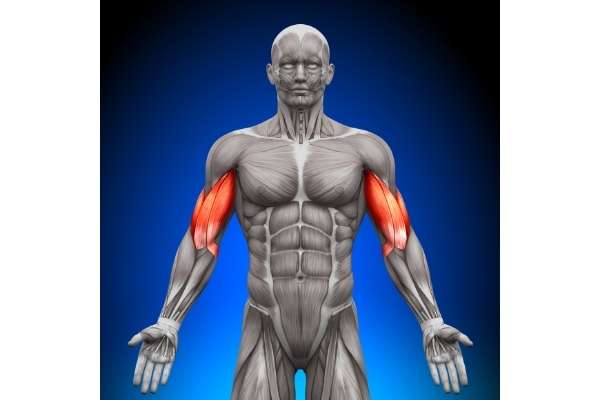
The biceps are actually comprised of two smaller muscles- the biceps brachii and brachiallis.
The biceps brachii is also further made up of a long and short head.
Together, these muscles work to flex the forearm towards your upper arm.
Many people spend a lot of time training the biceps, with very little results to show.
In fact, the biceps are one of the hardest muscles for beginners to build.
Why the biceps are hard to build:
Many people are unaware that the biceps muscles are responsible for different movements.
Therefore you need to perform a range of bicep curl variations to hit all your biceps muscles.
These variations need to include different grip-widths and grip styles in order to maximize bicep hypertrophy.
Another reason the biceps are hard to build is due to overtraining.
All the upper body pulling exercises also engage the biceps to some degree.
As such, you should limit the number of bicep curl sets to avoid exceeding the recommended training volume for bicep growth.
How to build the biceps:
- Underhand bicep curl.
- Reverse curl.
- Hammer curl.
- Concentration curl.
- Preacher curl.
- Compound pulling exercises such as pull-ups, chin-ups, and rows.
The majority of your bicep work should come from your compound pulling exercises like the row and pull up.
A pullup-tower like the Sports Royal allows you to do this at home.
These can then be supplemented with bicep accessory exercises such as the underhand curl, reverse curl, and preacher curl.
And dumbbells like the Powerblocks allow you to do these exercises at home
Tip: To get a maximal bicep contraction, rotate your wrist upwards as you curl.
Additionally, you should also stick to around 3-6 sets of accessory exercises per week if you are performing a lot of compound pulling exercises.
This will decrease the likelihood of overtraining.
Check out my other article to find out your ideal bicep curling weight!
5) Deltoids.
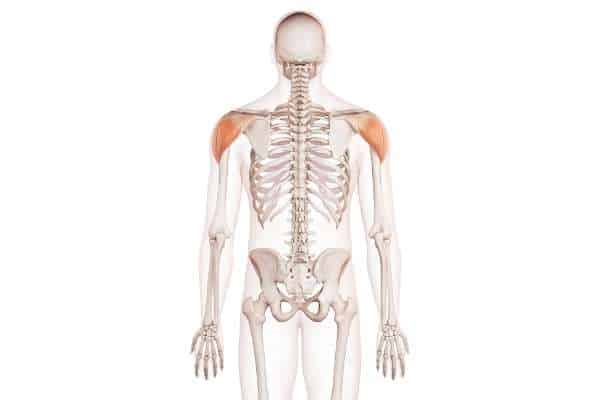
The deltoids are comprised of the anterior (front), medial (side), and posterior (back) deltoids.
Combined, this triplet of muscles moves the arm away from the body, whether that be forward, sideways, or backward.
When the deltoids are developed, they will widen your frame and are a major contributor to the v-shaped physique.
As such, you should find ways to effectively promote deltoid growth!
Why the deltoids are hard to build:
There are 3 main reasons why many people find the deltoids to be one of the more difficult muscles to build.
The first reason is not doing enough sets. Many people don’t prioritize the shoulders enough.
Instead, they treat the shoulders as a secondary muscle (with the chest, back, and legs being given the most attention).
Secondly is using too much weight. This compromises form and results in sub-optimal deltoid activation.
The classic example of this is loading too much on the shoulder press and arching your back due to the weight being too heavy.
This effectively turns the movement into an incline bench press, which is not great for big shoulders!
The third reason is not doing enough work on the medial deltoids.
The shoulder press is good for anterior deltoid activation. But the lateral raise is best for activating the medial deltoids. And that’s what widens your shoulders!
How to build the deltoids:
- Dumbbell hammer press.
- Barbell shoulder press.
- Lateral raise.
- Incline reverse fly.
- High pull.
You should use a lighter weight to maintain good form.
This is especially important for isolation-type shoulder exercises because like lateral raises.
Doing shoulder exercises with bad form can easily cause you to unintentionally turn the exercise into a different exercise (See shoulder press example above).
The individual deltoids are not big muscles. So you don’t need to overload them with heavy weights.
Instead, use moderate to light weights and perform around 12-15 reps per set with good form.
The Powerblock Elites contain heavy and lightweight settings in a single unit, making them perfect for doing both the overhead press and lateral raise at home.
You can read my other articles to find out how much weight to dumbbell shoulder press and lateral raise.
6) Hamstrings.
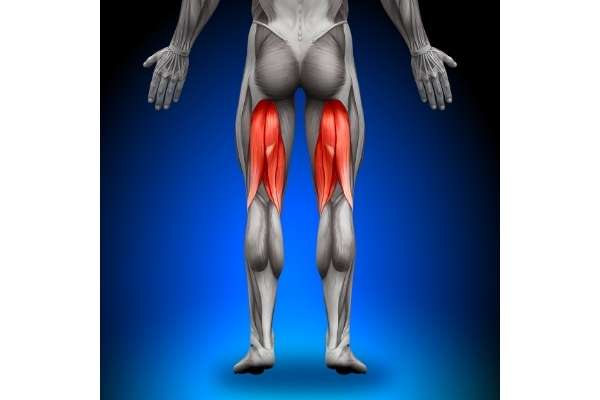
The hamstrings are located on the rear of your leg and serve to bring the leg backward.
Although the “hammies” are relatively non-visible compared to the quads, they serve an important function.
Along with the glutes, the hamstrings are the most powerful muscles in your lower body.
As such, they help you to lift heavy on leg days.
Additionally, highly trained hamstrings will visually thicken your legs when viewed from the rear and sides!
Why the hamstrings are hard to build:
Like the deltoids, many people simply ignore the hamstrings. Or they don’t give the hamstrings enough attention.
All lower body exercises will engage the hamstrings, either as the primary mover or secondary stabilizing muscle.
But the hamstrings are a large muscle. And this means they need to be hit hard and with lots of sets.
Another reason is poor form.
You need to remember the hamstring doesn’t just flex the knee joint, but also the hip joint.
As such, exercises such as the leg curl require you to consciously curl from the hip as well as from the knees. This will maximize hamstring activation.
How to build the hamstrings:
- Deadlift.
- Romanian deadlift.
- Low-bar back squat.
- Lunge.
- Leg curl.
- Nordic ham curl.
Hamstring training should revolve around heavy compound lower-body lifts (deadlifts, squats, and lunges).
These should also be supplemented with smaller accessory exercises such as the leg curl and ham curl.
With the accessory exercises, you should vary the weights.
In other words, do low reps with heavy weights as well as high reps with light weights.
That’s because the hamstrings have an even distribution of slow and fast-twitch fibers. And you’ll want to train both of them for maximal results.
The best way to train the hamstrings at home is with deadlifts and stiff-legged deadlifts.
To do this at home, you’ll need a good barbell like the CAP Olympic barbell with weight plates like the Balance From cast iron plates.
If you’re a beginner struggling to gain noticeable muscle, you can check out my home workout for skinny guys to gain muscle fast!
7) Pectorals.
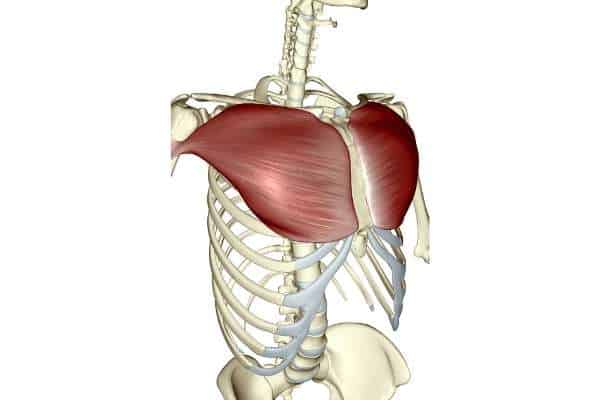
The pectorals comprise the pectoralis major and minor.
The pec major spans the entire breadth of the chest, whilst the pec minor sits underneath the pec major.
They both perform the same task- to bring the arms towards the torso midline.
These are probably some of the more famous upper body muscles. You probably already know what big pecs look like! And you probably want them for yourself.
Why the pecs are hard to build:
Many people struggle to build bigger pecs for two reasons.
The first reason is bad form.
When you bench press, you should make a conscious effort to widen your grip and squeeze the pecs as you press the bar.
Otherwise what happens is your triceps and anterior deltoids take the brunt of the work.
As a result, the pecs aren’t stimulated as much as you think they are.
The second reason is a lack of variety.
Although the pectoralis major counts as one muscle, it spans a great deal of surface area.
In fact, the pec major is further classified into the upper, mid, and low pecs.
And these should be targeted with different exercises, respectively.
How to build the pecs:
- Flat bench press (mid pecs).
- Incline bench press (upper pecs).
- Decline bench press (lower pecs).
- Chest fly.
- Dumbbell pull over.
- Cable flyes at different angles.
Bench presses should be performed at heavyweights with 8 to 12 reps per set.
Really concentrate on using your pectorals to press the bar upwards. Arching your back upwards will help with this.
In contrast, chest flyes should be performed with lighter weights at 12 to 15 reps per set.
Regardless of exercise choice, you should maintain good form and really feel your chest contract!
In my opinion, a dumbbell and bench setup is the best way to effectively build pecs at home.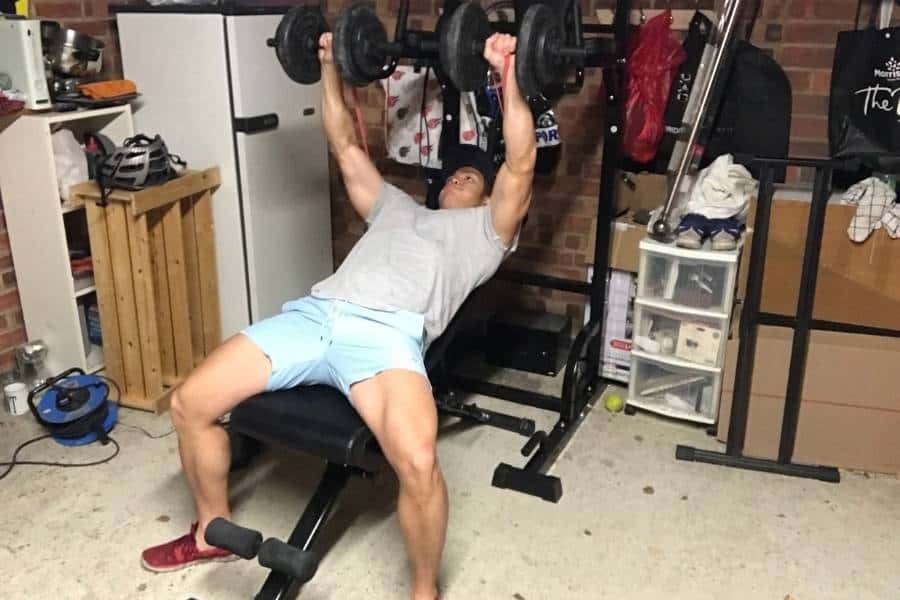
I use the Powerblock Elites with the Flybird adjustable bench.
The Powerblocks can be used for both heavy bench pressing as well as lighter-weight chest flyes. And the Flybird bench is fully adjustable which allows you to hit all your pectoral regions.
Check out my other article to find out why your pecs aren’t growing!
Recommended Equipment In This Article
Here’s an overview of the equipment listed in this article and why they are great for hitting the muscles mentioned in this post:
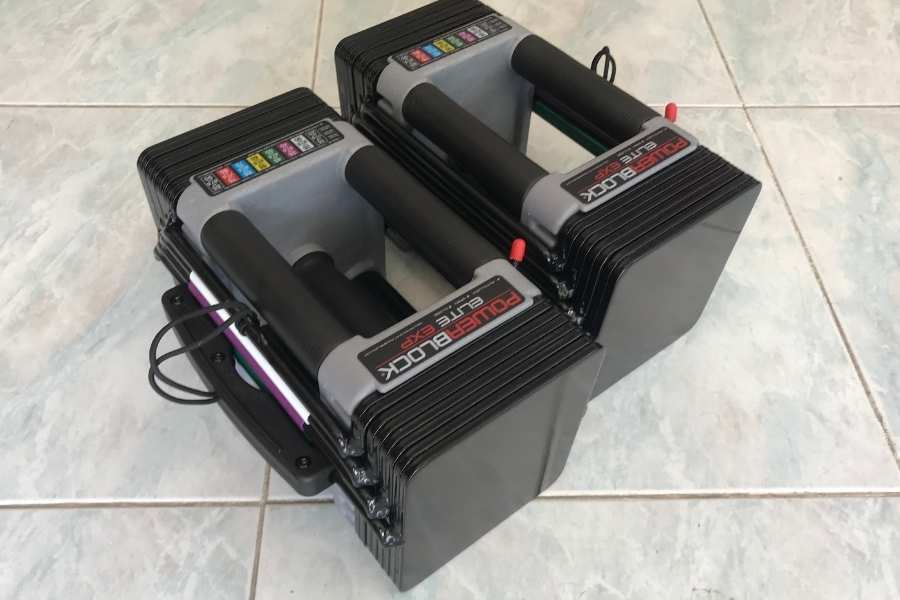
1) Heavy Adjustable Dumbbell- Powerblock Elites
These are fully adjustable from 2.5lbs to 90lbs per dumbbell (with the add-on kit).
This makes them great for both heavy upper-body compound lifting (bench press, shoulder press, rows, and their variations), as well as for light isolation-type lifting (dumbbell flyes, lateral raises, reverse flys, and weighted sit-ups).
They work well with the Flybird adjustable bench (see below).
2) Heavy Barbell With Weight Plates And Rack- CAP Barbell and Balance From Plates
A heavy barbell and rack are essential for maximizing squat and deadlift gains.
This makes them great for those looking to build and tone the lower body.
A barbell can also be used for hip thrusts that target the glutes.
You can find the cheapest CAP barbell price here, Balance From plates here, and the Bang Tong rack here.
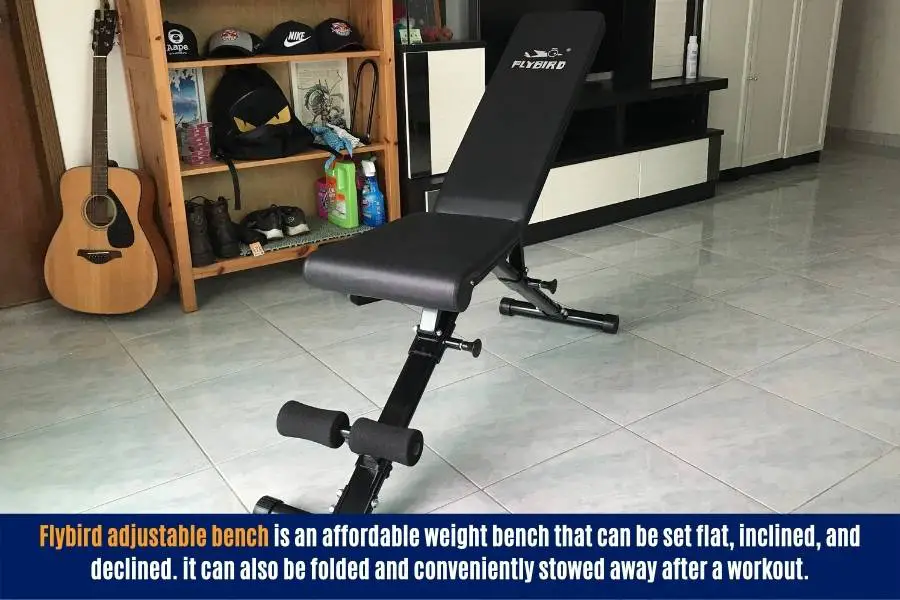
3) Adjustable Bench- Flybird Adjustable Bench
No home gym is complete without a bench.
An adjustable bench like the Flybird allows you to do flat/incline/decline bench pressing and flyes, seated shoulder presses, and decline sit-ups.
Therefore it’s a great purchase for upper-body training.
You can also use it for hip thrusts.
This bench can also be folded and stowed away after your workout.

4) Pull-Up Bar- Sports Royal Power Tower
A pull-up bar allows you to do pull-ups and chin-ups at home (one of the best back-builders).
I prefer to use a power tower.
I found doorway pull-up bars to be cheap but they also damage your property, especially if it isn’t properly installed.
The Sports Royal tower doesn’t physically screw into the wall/floor, yet provides great stability.
It can also be used to do chest dips (for arms and chest) and leg raises (for lower abs).
Conclusion
Today, I’ve researched, ranked, and shared with you the easiest and hardest muscles to build.
There seems to be a correlation between muscle size and the perceived difficulty to build it.
More specifically, the larger muscles are easier to build, whilst the smaller muscles are harder to build.
My list gives you an idea of how difficult/easy it’ll be to work on your own muscles.
But remember that everyone is different.
How difficult/easy you find it to build a particular muscle will depend on your own personal factors (largely your genetics and how much you enjoy training a specific muscle).
Which muscles do you find easiest and hardest to build?
Let me know in the comments below!
Alternatively, download the FREE Kalibre Muscle Blueprint to find out EXACTLY how I transformed my skinny body as a hardgainer!
Thanks for reading guys!
Peace Out,
Kal
(Biochemistry BSc, Biomedical Sciences MSc, Ex-Skinny Guy)


